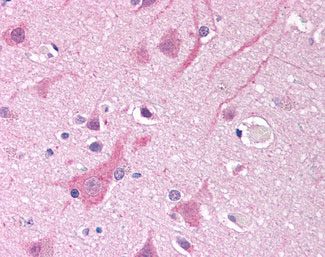SCN5A / Nav1.5 Antibody (Internal)
Goat Polyclonal Antibody
- SPECIFICATION
- CITATIONS
- PROTOCOLS
- BACKGROUND

Application
| IHC-P, E |
|---|---|
| Primary Accession | Q14524 |
| Reactivity | Human |
| Host | Goat |
| Clonality | Polyclonal |
| Calculated MW | 227kDa |
| Dilution | ELISA (1:32000), IHC-P (5-10 µg/ml), |
| Gene ID | 6331 |
|---|---|
| Other Names | Sodium channel protein type 5 subunit alpha, HH1, Sodium channel protein cardiac muscle subunit alpha, Sodium channel protein type V subunit alpha, Voltage-gated sodium channel subunit alpha Nav1.5, SCN5A |
| Target/Specificity | Human SCN5A / Nav1.5. This antibody is expected to recognise all reported isoforms (NP_932173.1; NP_000326.2; NP_001092874.1; NP_001092875.1). |
| Reconstitution & Storage | Store at -20°C. Minimize freezing and thawing. |
| Precautions | SCN5A / Nav1.5 Antibody (Internal) is for research use only and not for use in diagnostic or therapeutic procedures. |
| Name | SCN5A (HGNC:10593) |
|---|---|
| Function | Pore-forming subunit of Nav1.5, a voltage-gated sodium (Nav) channel that directly mediates the depolarizing phase of action potentials in excitable membranes. Navs, also called VGSCs (voltage- gated sodium channels) or VDSCs (voltage-dependent sodium channels), operate by switching between closed and open conformations depending on the voltage difference across the membrane. In the open conformation they allow Na(+) ions to selectively pass through the pore, along their electrochemical gradient. The influx of Na(+) ions provokes membrane depolarization, initiating the propagation of electrical signals throughout cells and tissues (PubMed:1309946, PubMed:21447824, PubMed:23085483, PubMed:23420830, PubMed:25370050, PubMed:26279430, PubMed:26392562, PubMed:26776555). Nav1.5 is the predominant sodium channel expressed in myocardial cells and it is responsible for the initial upstroke of the action potential in cardiac myocytes, thereby initiating the heartbeat (PubMed:11234013, PubMed:11804990, PubMed:12569159, PubMed:1309946). Required for normal electrical conduction including formation of the infranodal ventricular conduction system and normal action potential configuration, as a result of its interaction with XIRP2 (By similarity). |
| Cellular Location | Cell membrane; Multi-pass membrane protein {ECO:0000250|UniProtKB:P15389}. Cytoplasm, perinuclear region. Cell membrane, sarcolemma, T- tubule {ECO:0000250|UniProtKB:P15389}. Cell junction {ECO:0000250|UniProtKB:P15389}. Note=RANGRF promotes trafficking to the cell membrane. Colocalizes with PKP2 at intercalated disks in the heart (By similarity). {ECO:0000250|UniProtKB:P15389, ECO:0000269|PubMed:21447824, ECO:0000269|PubMed:23420830} |
| Tissue Location | Found in jejunal circular smooth muscle cells (at protein level). Expressed in human atrial and ventricular cardiac muscle but not in adult skeletal muscle, brain, myometrium, liver, or spleen. Isoform 4 is expressed in brain. |
| Volume | 50 µl |

Thousands of laboratories across the world have published research that depended on the performance of antibodies from Abcepta to advance their research. Check out links to articles that cite our products in major peer-reviewed journals, organized by research category.
info@abcepta.com, and receive a free "I Love Antibodies" mug.
Provided below are standard protocols that you may find useful for product applications.
Background
This protein mediates the voltage-dependent sodium ion permeability of excitable membranes. Assuming opened or closed conformations in response to the voltage difference across the membrane, the protein forms a sodium-selective channel through which Na(+) ions may pass in accordance with their electrochemical gradient. It is a tetrodotoxin-resistant Na(+) channel isoform. This channel is responsible for the initial upstroke of the action potential. Channel inactivation is regulated by intracellular calcium levels.
References
Gellens M.E.,et al.Proc. Natl. Acad. Sci. U.S.A. 89:554-558(1992).
Ou Y.,et al.Neurogastroenterol. Motil. 14:477-486(2002).
Makielski J.C.,et al.Circ. Res. 93:821-828(2003).
Ye B.,et al.Physiol. Genomics 12:187-193(2003).
Ou S.-W.,et al.Eur. J. Neurosci. 22:793-801(2005).
If you have used an Abcepta product and would like to share how it has performed, please click on the "Submit Review" button and provide the requested information. Our staff will examine and post your review and contact you if needed.
If you have any additional inquiries please email technical services at tech@abcepta.com.













 Foundational characteristics of cancer include proliferation, angiogenesis, migration, evasion of apoptosis, and cellular immortality. Find key markers for these cellular processes and antibodies to detect them.
Foundational characteristics of cancer include proliferation, angiogenesis, migration, evasion of apoptosis, and cellular immortality. Find key markers for these cellular processes and antibodies to detect them. The SUMOplot™ Analysis Program predicts and scores sumoylation sites in your protein. SUMOylation is a post-translational modification involved in various cellular processes, such as nuclear-cytosolic transport, transcriptional regulation, apoptosis, protein stability, response to stress, and progression through the cell cycle.
The SUMOplot™ Analysis Program predicts and scores sumoylation sites in your protein. SUMOylation is a post-translational modification involved in various cellular processes, such as nuclear-cytosolic transport, transcriptional regulation, apoptosis, protein stability, response to stress, and progression through the cell cycle. The Autophagy Receptor Motif Plotter predicts and scores autophagy receptor binding sites in your protein. Identifying proteins connected to this pathway is critical to understanding the role of autophagy in physiological as well as pathological processes such as development, differentiation, neurodegenerative diseases, stress, infection, and cancer.
The Autophagy Receptor Motif Plotter predicts and scores autophagy receptor binding sites in your protein. Identifying proteins connected to this pathway is critical to understanding the role of autophagy in physiological as well as pathological processes such as development, differentiation, neurodegenerative diseases, stress, infection, and cancer.


